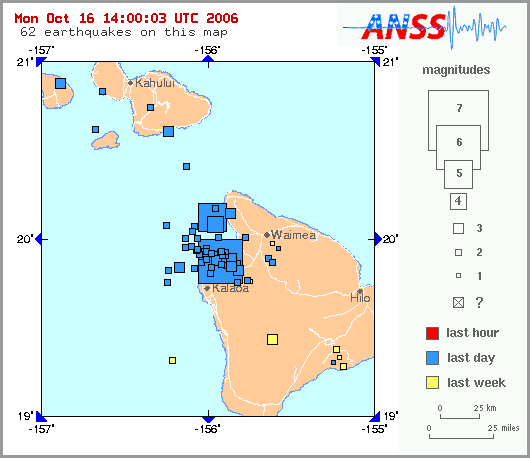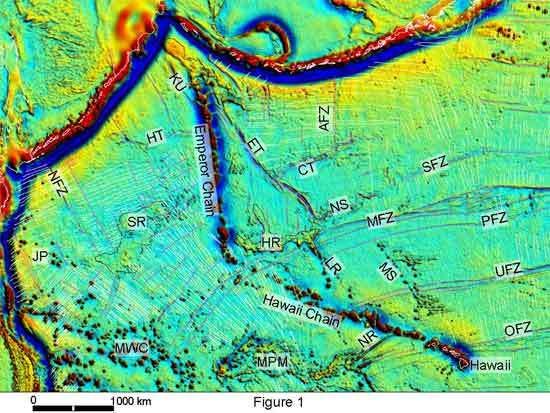Far be it for me to refuse a request. In the comments to my last post:
I can't find an email address for you or a more appropriate place to post a question. I'm looking for someone, anyone, who has any ideas about the cause of Sunday's Hawaiian earthquake. I've posted the question on my blog at ElementList [where there is a very cool photo of a rockfall triggered by the quake]. The quake was very deep (~38 km) and was strike-slip. This seems like an odd place for that kind of quake. Any ideas?
This is an interesting one – I should warn that most of what follows will be speculation (informed speculation, perhaps…). First, lets have a look at the USGS moment tensor solution:

Note that the depth is now being reported as 28 km, which is deeper than a lot of the normal seismicity, but not unusually so. However, the size and the location of this earthquake are both unusual. For comparison, here’s a map of seismicity on the Big Island for the year 2000 (from the Hawaii Volcano Observatory).

As you can see, earthquakes are hardly rare on Hawaii; the emptying and filling of magma chambers, and molten rock moving to the surface, all produce stresses which result in earthquakes. However, they are pretty much all less than magnitude 4, more than 400 times less powerful than today’s 6.6. Also noteworthy is that a lot of the seismicity is concentrated underneath the volcanoes, as you would expect if it is associated with magma movement; in contrast, today’s quake and aftershocks, as shown in the figure below (source) were located off the NW coast of the Big Island.

All of this suggests that this earthquake is not associated with the volcanism. So what is the cause? Two possibilities spring to mind:
- The Hawaian islands are 5 km-high piles of basalt that represent a very large load on the oceanic crust and lithosphere beneath them, causing it to bend downwards around the bases of the seamounts. The earthquake could be releasing some of the stress building up as the islands continue to grow.
- Although most deformation on the Earth occurs at plate boundaries, some stresses are still transmitted to the interior of plates, where they cause intra-plate earthquakes at weak points. It could be that the crust around Hawaii is such a weak point. My first thought that this was an effect of the hotspot volcanism (lots of cracks for magma migration, etc.). But then another thought occurred. Here’s a bathymetric map of the Northern Pacific:

See those long, linear features? They’re oceanic fracture zones, the inactive parts of the transform faults which separate the spreading centres of mid-ocean ridges (these Pacific ones eventually join the East Pacific Rise just off the west coast of the Americas). And one of these fracture zones, the Molokai Fracture Zone (rather bizarrely abbreviated as OFZ in this particular image) just happens to intersect with the Hawaian Islands. It’s quite common for inter-plate earthquakes to occur on old faults, as they’re much weaker than surrounding rock, and the focal plane solution is consistent with an E-W trending structure.
So that’s my guess: this earthquake is accommodating large-scale, intra-plate strains in the Pacific plate (shifting up into really speculative, I’ll note the nice correlation to the ~NW absolute motion of the Pacific plate - see here for example), and may be due to reactivation of an old fracture zone, or a structure associated with it. More knowledgeable heads are free to weigh in and correct me...
[Update: Western Geologist has a good post up pointing out that there's a big difference between the USGS focal mechanism given above and the Havard CMT solution, the latter indicating an oblique extensional fault - more consistent with the quake being a response to plate loading - rather than strike slip and suggesting that the focal planes may not be well constrained. He's also dug out the locations and mechanisms of other large (non-volcanism related) quakes in the last 20 years, and discusses how they relate to this weeks'.]




7 comments:
I've got a quick commet. I think reactivation of a structure associated with the fracture zone is a cool idea, but there's no reason that an earthquake caused by reactivation on an ancient strike slip fault would have to be strike slip. The modern stress state would certainly be different from the one that existed when it was active so there's no reason that modern motion on a structure associated with the fracture zone would have to be strike slip.
I am doing so poorly with spelling lately. My apologies. 'commet' should be 'comment'
I agree - which is why I was looking for a cause other than loading of the Pacific lithosphere by the Hawaian Island (where I'd have expected any old fault to be reactivated as a thrust, or at least to have a component of vertical motion), and idly wondering about a link to more large scale, inter-plate stresses; the WNW-ish absolute motion of the Pacific Plate might result in a stress field conducive to a strike-slip reactivation of the old fracture zone structures.
I've expanded a bit at my blog. That way I could upload a few figures.
I don't think the stress field would have to be all that different to have a strike slip as opposed to a thrust event. If the intermediate and least principle stresses are similar in magnitude then it wouldn't take much to make them switch, which (with the greatest principle stress horizontal) would switch the style of faulting from thrust to strike slip.
Thanks WG - I've linked to your discussion in the main post. Interesting stuff!
I really wish someone would calculate the focal mechanisms for the events recorded by the HVO network. That would be quite a dataset.
Just wanted to let you know that this post has been included in the third installment of the Philosophia Naturalis blog carnival (dedicated to the physical sciences and technology). You can see it all here:
http://geekcounterpoint.net/files/GC046B.html
Lorne Ipsum
Chief Geek, Geek Counterpoint blog & podcast
Post a Comment